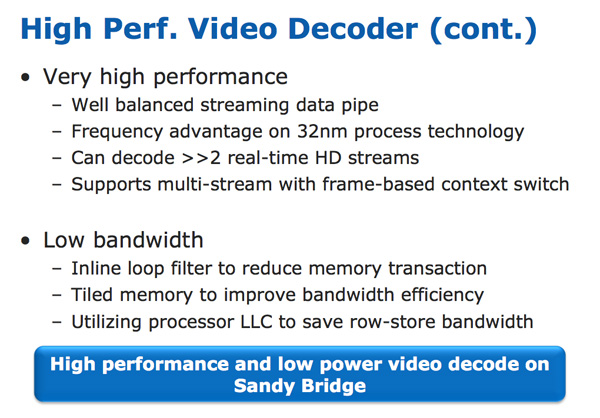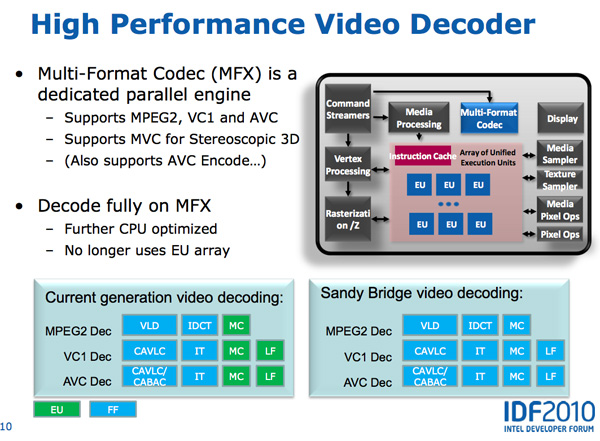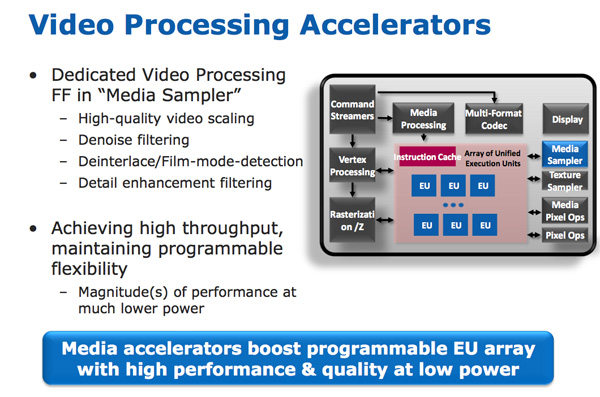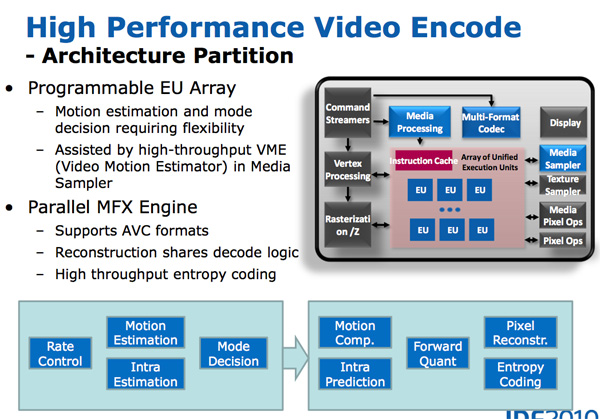The Sandy Bridge Review: Intel Core i7-2600K, i5-2500K and Core i3-2100 Tested
by Anand Lal Shimpi on January 3, 2011 12:01 AM ESTIntel’s Quick Sync Technology
In recent years video transcoding has become one of the most widespread consumers of CPU power. The popularity of YouTube alone has turned nearly everyone with a webcam into a producer, and every PC into a video editing station. The mobile revolution hasn’t slowed things down either. No smartphone can play full bitrate/resolution 1080p content from a Blu-ray disc, so if you want to carry your best quality movies and TV shows with you, you’ll have to transcode to a more compressed format. The same goes for the new wave of tablets.
At a high level, video transcoding involves taking a compressed video stream and further compressing it to better match the storage and decoding abilities of a target device. The reason this is transcoding and not encoding is because the source format is almost always already encoded in some sort of a compressed format. The most common, these days, being H.264/AVC.
Transcoding is a particularly CPU intensive task because of the three dimensional nature of the compression. Each individual frame within a video can be compressed; however, since sequential frames of video typically have many of the same elements, video compression algorithms look at data that’s repeated temporally as well as spatially.
I remember sitting in a hotel room in Times Square while Godfrey Cheng and Matthew Witheiler of ATI explained to me the challenges of decoding HD-DVD and Blu-ray content. ATI was about to unveil hardware acceleration for some of the stages of the H.264 decoding pipeline. Full hardware decode acceleration wouldn’t come for another year at that point.
The advent of fixed function video decode in modern GPUs is important because it helped enable GPU accelerated transcoding. The first step of the video transcode process is to first decode the source video. Since transcoding involves taking a video already in a compressed format and encoding it in a new format, hardware accelerated video decode is key. How fast a decode engine is has a tremendous impact on how fast a hardware accelerated video encode can run. This is true for two reasons.
First, unlike in a playback scenario where you only need to decode faster than the frame rate of the video, when transcoding the video decode engine can run as fast as possible. The faster frames can be decoded, the faster they can be fed to the transcode engine. The second and less obvious point is that some of the hardware you need to accelerate video encoding is already present in a video decode engine (e.g. iDCT/DCT hardware).
With video transcoding as a feature of Sandy Bridge’s GPU, Intel beefed up the video decode engine from what it had in Clarkdale. In the first generation Core series processors, video decode acceleration was split between fixed function decode hardware and the GPU’s EU array. With Sandy Bridge and the second generation Core CPUs, video decoding is done entirely in fixed function hardware. This is not ideal from a flexibility standpoint (e.g. newer video codecs can’t be fully hardware accelerated on existing hardware), but it is the most efficient method to build a video decoder from a power and performance standpoint. Both AMD and NVIDIA have fixed function video decode hardware in their GPUs now; neither rely on the shader cores to accelerate video decode.
The resulting hardware is both performance and power efficient. To test the performance of the decode engine I launched multiple instances of a 15Mbps 1080p high profile H.264 video running at 23.976 fps. I kept launching instances of the video until the system could no longer maintain full frame rate in all of the simultaneous streams. The graph below shows the maximum number of streams I could run in parallel:
| Intel Core i5-2500K | NVIDIA GeForce GTX 460 | AMD Radeon HD 6870 | |
| Number of Parallel 1080p HP Streams | 5 streams | 3 streams | 1 stream |
AMD’s Radeon HD 6000 series GPUs can only manage a single high profile, 1080p H.264 stream, which is perfectly sufficient for video playback. NVIDIA’s GeForce GTX 460 does much better; it could handle three simultaneous streams. Sandy Bridge however takes the cake as a single Core i5-2500K can decode five streams in tandem.

The Sandy Bridge decoder is likely helped by the very large (and high bandwidth) L3 cache connected to it. This is the first advantage Intel has in what it calls its Quick Sync technology: a very fast decode engine.
The decode engine is also reused during the actual encode phase. Once frames of the source video are decoded, they are actually fed to the programmable EU array to be split apart and prepared for transcoding. The data in each frame is transformed from the spatial domain (location of each pixel) to the frequency domain (how often pixels of a certain color appear); this is done by the use of a discrete cosine transform. You may remember that inverse discrete cosine transform hardware is necessary to decode video; well, that same hardware is useful in the domain transform needed when transcoding.
Motion search, the most compute intensive part of the transcode process, is done in the EU array. It's the combination of the fast decoder, the EU array, and fixed function hardware that make up Intel's Quick Sync engine.













283 Comments
View All Comments
iwodo - Monday, January 3, 2011 - link
1. Transcoding @ 100fps is not uber fast. x264 ultrafast setting is even faster then that. So i hope there are further improvement or potentials in the Quick Sync that we haven't yet discovered.2. OpenCL - No mention of OpenCL? At all?
3. I would think Intel GD has done very well this time around. And there are possibly 20 - 30% more performance to squeeze out given how Intel Gfx Drivers tend to be VERY POOR.
cactusdog - Monday, January 3, 2011 - link
Thanks for the excellent run down of Sandy Bridge. As i have a x58 system i'm going to skip it and see what happens in Q4 . X58 has been a good platform and lasted longer than most others in recent years.xxxxxl - Monday, January 3, 2011 - link
I've thought it over...and i don't believe that H67 only support GPU overclocking.Like what others said, buy a "K" cpu to get HD3000 graphic and cannot overclock...and on the other side, those with P67 buy unlocked "K" CPU get HD3000 but cannot use...then what's the point of making HD3000 graphics?
strikeback03 - Tuesday, January 4, 2011 - link
As they pointed out, with the Z series motherboard you can have both. That said, it does seem stupid that Intel would launch with those official guidelines, and in these comments others are saying some H67 motherboards are allowing the CPU multiplier to be changed.rs2 - Monday, January 3, 2011 - link
As tempting is this chip looks, my 3.8 GHz Core 2 Quad is still more CPU than I can really use most of the time. I wonder if we're reaching the point where improved compute performance is not really necessary for mainstream and even most enthusiast users.In any case, the upcoming 6-core/12-thread variant sounds interesting. Maybe I'll upgrade to that if Intel doesn't assign it to the $999 price point.
romanovskis - Monday, January 3, 2011 - link
same here. For gaming or multimedia use, core2quad (mine at 4GHz) is still enough, and probably will be enough for 1-2 years. Best value/money is still in GPU upgrades.iwodo - Monday, January 3, 2011 - link
Beat Value / Money is SSD...cgeorgescu - Monday, January 3, 2011 - link
Best Value/Money is Beer, everybody knows that. Not 6-core but 6-pack.karlostomy - Thursday, January 6, 2011 - link
WIN ^^^agr8man - Monday, January 3, 2011 - link
a great review from you guys, and imo, the i5 2500k is really a steal.